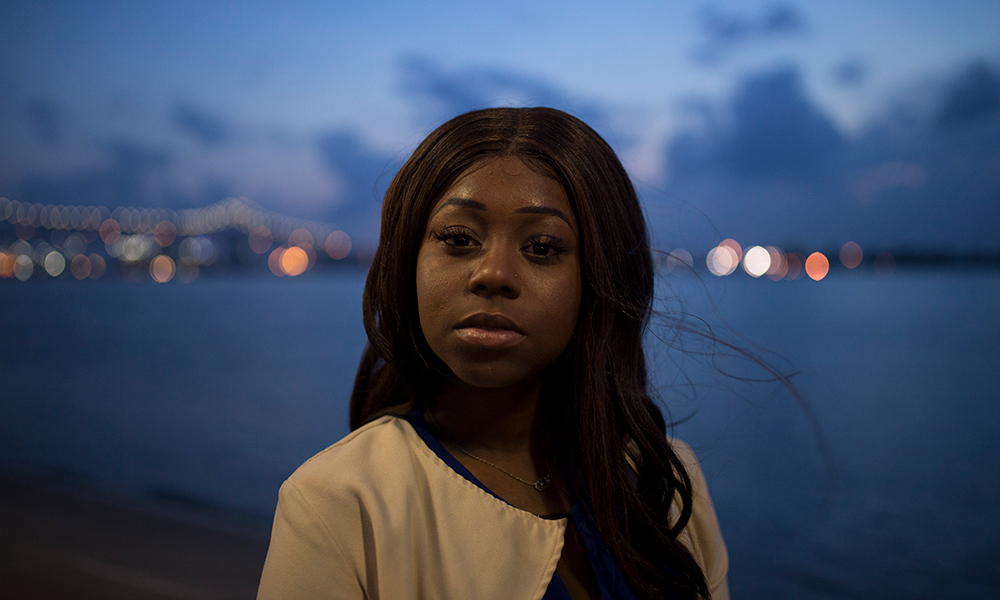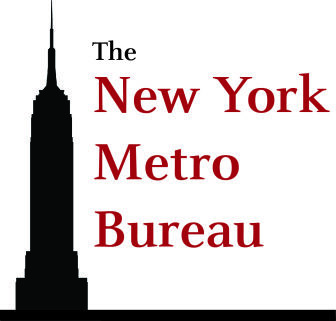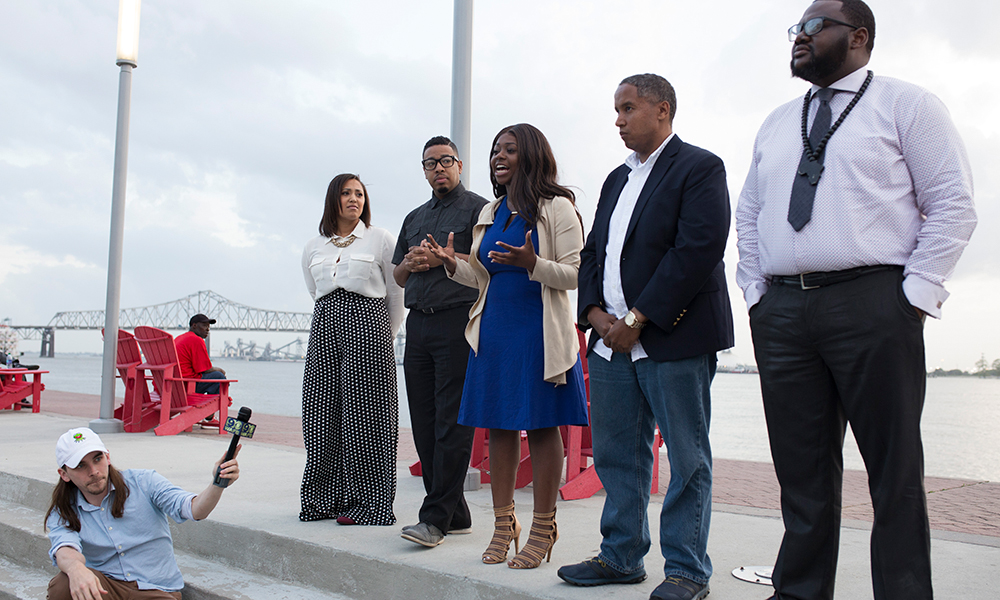
Photos by Clarissa Sosin
Youth organizer Myra Richardson said she wants to challenge the Good Old Boy network that runs Baton Rouge.
BATON ROUGE, Louisiana — The 19-year-old young black woman born in a poor neighborhood called Dixie doesn’t just want to challenge the Good Old Boy network that runs things in this city.
“It’s more like obliterate,” Myra Richardson said with a wide smile. “Obliterate, that’s the word.”
It is a system she says that has called the shots for generations. But not for much longer, if she and her fellow youth activists achieve their goal of mobilizing the youth not just for street action but political action as well.
“It’s not just one person,” she said. “It’s like this entity that has always persisted in this country’s history, and in this city.”
 Richardson expressed that ambition after she had just finished speaking at a press conference to announce actions that activists like her and others in Louisiana’s capital city were planning in the wake of an announcement Tuesday that the two officers involved in the widely publicized shooting of Alton Sterling would not face criminal prosecution.
Richardson expressed that ambition after she had just finished speaking at a press conference to announce actions that activists like her and others in Louisiana’s capital city were planning in the wake of an announcement Tuesday that the two officers involved in the widely publicized shooting of Alton Sterling would not face criminal prosecution.
At the press conference, Richardson, who through her youth led social justice organization The Wave, helped organize the protests in the immediate aftermath of the shooting, hinted at more upcoming protests after a scheduled press conference Friday afternoon. That’s when the city said it would announce the fate of the two officers involved in the Sterling killing. Many observers of the case expect the city to fire one of the officers and retain the other.
“This isn’t just an isolated event — this could’ve been our brother, this could’ve been our sister, this could’ve been me,” she said, her voice filled with palpable emotion. “We look at this moment of tragedy to mobilize and organize the youth.”
Another Blow to Baton Rouge
The decision not to criminally charge the officers was another blow from a leadership that is ignoring the young people in the city, she said. The youth are fed up with the status quo, Richardson said, and are ready to use their energy to change it.
“We have come with the fire and the fury like no other,” she said. “We’re conserving our effort for the big shebang.”
But Richardson, along with other leaders, said the mobilization will be more than just a protest — they are planning a campaign to both register people to vote and to get them out to vote in 2020 so they can change the leadership that was behind Tuesday’s decision.
“We understand at this time that people are hurting, people are angry, They’re frustrated,” said Antoine Pierce, 36, a community activist who is pitching in to help Richardson organize. “But it is up to us to channel that emotion into something positive.”

Myra Richardson speaks with a Baton Rouge reporter after the press conference.
Two offices that are up for election are the attorney general, who decided not to bring charges, and the district attorney who recused himself from the case.
“We are no longer OK with our politicians, our civil servants or the people who are supposedly there to represent us. And in 2020 we will no longer see any of these people in positions,” Richardson said. “We will see our needs and desires represented. We will not take no for an answer. The future looks like us, the future is us. And we will not stop — we can’t.”
Fellow activist Eugene Collins, 33, who stood by Richardson at the press conference, said he is impressed and motivated by her activism and passion at such a young age. He said it is always young people like Richardson who brought the energy.
“I’m glad to see that young people like Myra are stepping up and wanting change. It means they’re coming up the right way — and that’s change right there.”
An Eye Opening Bus Ride to School
After the press conference, Richardson sat on a bench overlooking the Mississippi River. Behind her stretched Florida Street, the unofficial Mason-Dixon line in Baton Rouge that separates blacks from whites, the haves from have nots. Crossing this road as a child going to school, or rumbling off to field trips, introduced her to inequality and awakened a sense of mission in her.
Richardson’s road to fighting for social justice began on those bus rides to school. She was in the best schools in the city, so she was bussed out of her neighborhood to the magnet programs. She would look out the window of her bus and see the blight of the Dixie neighborhood jarringly transform into the wealth of the nicer neighborhoods.
“It’s not like something that’s little by little; it’s an immediate dramatic change,” she said.
It was when she saw how girls like her lived on the other side of the Mason-Dixon line that she understood there were two very different worlds living side by side in her city. She drove past crumbling buildings and ruins of homes. And then was floored by what she saw on the other side.
“You’re going to see glass houses, you get to see this beautiful menagerie that exists,” she said. “But we don’t have that on the other side, we don’t even have bus stops, we don’t have sidewalks.”
People tell Richardson she is a radical. But, she says, all she wants is the same opportunities and the same rights that a woman on the other side of Florida Street enjoys.
“I think there are a lot of old practices in this city that perpetuate the system as well as hold us back from where we need to be,” she said.
Richardson said she is no different than many of the youth in the city.
“Some kids might not have the words for it or know the terminology of what is happening to them or the wrong that is happening to them,” she said.
“But they understand it; they get it.”
Richardson says she can name the system, and thinks that Baton Rouge exemplifies that system to its core.
“They call it New Jim Crow,” she said. “It’s things that were in segregation but they gave it new names. I think Baton Rouge is a pillar of an example of what that looks like.”
New Civil Rights Movement for New Jim Crow
Young people behind the push to transform Baton Rouge through protests and politics are part of a new civil rights movement to fight to dismantle the New Jim Crow, said Pierce, the community activist helping Richardson organize. During the civil rights movement, it was young people who often stood not just on the frontlines — doing sit ins at lunch counters and participating on Freedom Rides — but also took positions of leadership. There were teenagers, he said, like Richardson who risked their lives to change the world.

Myra Richardson and other activists held a press conference in downtown Baton Rouge on the banks of the Mississippi river about their next steps in response to the announcement that there will be no indictments in the shooting of Alton Sterling.
“Most people don’t know this, but Martin Luther King was only in his 30s when he died, so he was really young when he started,” said Pierce. “It’s just a continuation of that legacy — it's sad that we even have to continue that in 2018. What we’re seeing in this generation and not just from blacks, but whites and Hispanics — young people in general — it’s a continuation of a legacy that was started during the civil rights movement.”
Pierce has worked with Richardson in the past, most recently the two co-organized the March For Our Lives in Baton Rouge. Pierce said he is impressed with Richardson’s organizing skills.
“It’s astonishing,” he said. “She has an eye for the people, an ear for the people, I think she’s the future of leadership here. It’s really inspiring to step forward and say we won’t be silenced. We will be respected, we will be heard. We’re the future leaders — it’s our time.”
Richardson does not think there is any obstacle that can stop her and the young people in Baton rouge from accomplishing their goal of dismantling the Good Old Boy network and replacing them with their peers.
“I don’t think there’s anything tangible that can stop us. Not a person, not a law, not a policy,” she said. “These kids are the real deal.”
As she continues to fight for equity and representation, she said she appreciates growing up in a generation that has the luxury to take on the system and not have to worry about many of the things her predecessors had to worry about.
“I don’t think I would’ve made it in any other generation,” she said. “They was going to have to off me because I wouldn’t have been with it,” she continued laughing. “It would’ve been a wrap for me, it would’ve been a wrap.”